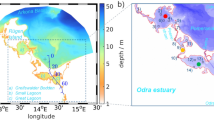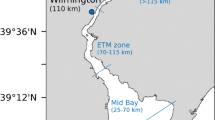Abstract
Nutrient dynamics in estuaries are temporally variable in response to changing physical–chemical conditions and biogeochemical processes involving primary producer groups such as phytoplankton, microphytobenthos, seagrass and macroalgae. In order to reveal intra-annual changes in the biomass of primary producer groups and associated changes in estuarine nutrient dynamics, we developed a box model, coupling water inflows and outflows and nitrogen dynamics in Wilson Inlet, a large, central-basin-dominated, intermittently closed estuary exposed to a Mediterranean climate in Western Australia. The model is calibrated and validated with monitoring data, aquatic plant biomass estimates and biogeochemical rate measurements. Macrophytes and their microalgal epiphytes appear to rapidly assimilate nutrients from the first flush from the catchment in winter, but this buffer capacity then ceases, and a phytoplankton ‘bloom’ develops in response to subsequent river runoff events in spring. Significant amounts of bioavailable nitrogen are exported to the ocean because phytoplankton predominance occurs while the sand bar is breached. Surface sediments play a key role for nitrogen dynamics: In late spring to autumn, high light availability at the sediment surface stimulates high primary production by microphytobenthos, leading to reduced benthic ammonium fluxes particularly in the deep basin. Microphytobenthos contributes about 60% of annual whole-system primary production. Despite high benthic primary production, nitrogen release from sediments is the biggest nitrogen source to the estuary.









Similar content being viewed by others
References
Brearley, A. 2005. Ernest Hodgkin’s Swanland: Estuaries and coastal lagoons of Southwestern Australia. Perth: University of Western Australia Press.
Carruthers, T.J.B., D.I. Walker, and G.A. Kendrik. 1999. Abundance of Ruppia megacarpa Mason in a seasonally variable estuary. Estuarine, Coastal and Shelf Science 48: 497–509.
Carstensen, J., P. Henriksen, and A.-S. Heiskanen. 2007. Summer algal blooms in shallow estuaries: Definition, mechanisms, and link to eutrophication. Limnology and Oceanography 52: 370–384.
Chapelle, A. 1995. A preliminary model of nutrient cycling in sediments of a Mediterranean lagoon. Ecological Modelling 80: 131–147.
Cloern, J.E. 2001. Our evolving conceptual model of the coastal eutrophication problem. Marine Ecology Progress Series 210: 223–253.
Dalsgaard, T. 2003. Benthic primary production and nutrient cycling in sediments with benthic microalgae and transient accumulation of macroalgae. Limnology and Oceanography 48: 2138–2150.
DoW WA. 2002. Water quality in Wilson Inlet from 1995 to 2002. Wilson Inlet Report to the Community No. 5. http://www.wicc.southcoastwa.org.au/reports.html. Accessed 7 July 2009.
DoW WA. 2003. Ruppia in Wilson Inlet. Wilson Inlet Report to the Community No. 7. http://www.wicc.southcoastwa.org.au/reports.html. Accessed 7 July 2009.
Duarte, C.M. 1992. Nutrient concentration of aquatic plants: Patterns across species. Limnology and Oceanography 37: 882–889.
Dudley, B.J., A.M.E. Gahnström, and D.I. Walker. 2001. The role of benthic vegetation as a sink for elevated inputs of ammonium and nitrate in a mesotrophic estuary. Marine Ecology Progress Series 219: 99–107.
Eyre, B.D., and A.J.P. Ferguson. 2009. Denitrification efficiency for defining critical loads of carbon in shallow coastal ecosystems. Hydrobiologia 629: 137–146.
Gale, E., C. Pattiaratchi, and R. Ranasinghe. 2007. Processes driving circulation, exchange and flushing within intermittently closing and opening lakes and lagoons. Marine and Freshwater Research 58: 709–719.
Grasshoff, K., M. Ehrhardt, and K. Kremling. 1983. Methods of sea water analysis. Weinheim: Chemie.
Grinham, A.R., R.J.B. Carruthers, P.L. Fisher, J.W. Udy, and W.C. Dennison. 2007. Accurately measuring the abundance of benthic microalgae in spatially variable habitats. Limnology and Oceanography: Methods 5: 119–125.
Haese, R.R., E.J. Murray, C.S. Smith, J. Smith, L. Clementson, and D.T. Heggie. 2007. Diatoms control nutrient cycles in a temperate, wave-dominated estuary (southeast Australia). Limnology and Oceanography 52: 2686–2700.
Heggie, D.T., G.W. Skyring, J. Orchardo, A.R. Longmore, G.J. Nicholson, and W.M. Berelson. 1999. Denitrification and denitrifying efficiencies in sediments of Port Phillip Bay: Direct determinations of biogenic N2 and N-metabolite fluxes with implications for water quality. Marine and Freshwater Research 55: 589–596.
Heggie, D.T., G.A. Logan, C.S. Smith, D.J. Fredericks, and D. Palmer. 2008. Biogeochemical processes at the sediment–water interface, Bombah Broadwater, Myall Lakes. Hydrobiologia 608: 49–67.
Howarth, R.W., R. Marino, J. Lane, and J.J. Cole. 1988. Nitrogen fixation in freshwater, estuarine, and marine ecosystems. I. Rates and importance. Limnology and Oceanography 33: 669–687.
Huang, C.-H., H.-J. Lin, T.-C. Hunag, H.-M. Su, and J.-J. Huang. 2008. Response of phytoplankton and periphyton to system-scale removal of oyster-culture racks from a eutrophic tropical lagoon. Marine Ecology Progress Series 358: 1–12.
Kostoglidis, A., C.B. Pattiaratchi, and D.P. Hamilton. 2005. CDOM and its contribution to the underwater light climate of a shallow, microtidal estuary in south-western Australia. Estuarine, Coastal and Shelf Science 63: 469–477.
Kramer, K., P. Fong, R. Kennison, and K. Schiff. 2004. Nutrient limitation of the macroalga Enteromorpha intestinalis collected along a resource gradient in a highly eutrophic estuary. Estuaries 27: 201–208.
Light, B.R., and J. Beardall. 2001. Photosynthetic characteristics of subtidal benthic microalgal populations from a temperate, shallow water marine ecosystem. Aquatic Botany 70: 9–27.
Lukatelich, R.J., N.J. Schofield, and J. McComb. 1987. Nutrient loading and macrophyte growth in Wilson Inlet, a bar-built southwestern Australian estuary. Estuarine, Coastal and Shelf Science 24: 141–165.
Murray, A.G., and J.S. Parslow. 1997. Port Phillip Bay integrated model: Final report. Technical report 44. Port Phillip Bay Environmental Study. Canberra: Commonwealth Scientific and Industrial Research Organisation.
Murray, A.G., and J.S. Parslow. 1999. Modelling of nutrient impacts in Port Phillip Bay—A semi-enclosed marine Australian ecosystem. Marine and Freshwater Research 50: 597–611.
Nixon, S.W. 1981. Remineralization and nutrient cycling in coastal marine ecosystems. In Estuaries and Nutrients, ed. B.J. Neilson and L.E. Cronin, 111–128. Clifton: Humana.
Nozais, C., R. Perissinotto, and S. Mundree. 2001. Annual cycle of microalgal biomass in a South African temporarily-open estuary: Nutrient versus light limitation. Marine Ecology Progress Series 223: 39–48.
Perissinotto, R., C. Nozais, and I. Kibirige. 2002. Spatio-temporal dynamics of phytoplankton and microphytobenthos in a South African temporarily-open estuary. Estuarine, Coastal and Shelf Science 55: 47–55.
Peters, N.E., and R. Donohue. 2001. Nutrient transport to the Swan-Canning Estuary, Western Australia. Hydrological Processes 15: 2555–2577.
Pitt, K.A., K. Koop, and D. Rissik. 2005. Contrasting contributions to inorganic nutrient recycling by the co-occurring jellyfish, Catostylus mosaicus and Phyllorhiza punctata (Scyphozoa, Rhizostomeae). Journal of Experimental Marine Biology and Ecology 315: 71–86.
Plus, M., A. Chapelle, P. Lazure, I. Auby, G. Levaseur, M. Verlaque, T. Belsher, J.M. Deslous-Paoli, J.M. Zaldívar, and C.N. Murray. 2003. Modelling of oxygen and nitrogen cycling as a function of macrophyte community in the Thau lagoon. Continental Shelf Research 23: 1877–1898.
Ragueneau, O., L. Chauvaud, B. Moriceau, A. Leynaert, G. Thouzeau, A. Donval, F. Le Loc’h, and F. Jean. 2005. Biodeposition of an invasive suspension feeder impacts the biogeochemical cycle of Si in a coastal ecosystem (Bay of Brest, France). Biogeochemistry 75: 19–41.
Ranasinghe, R., and C. Pattiaratchi. 1999. Circulation and mixing characteristics of seasonally open tidal inlet: A field study. Marine and Freshwater Research 50: 281–290.
Risgaard-Petersen, N. 2004. Denitrification. In Estuarine Nutrient Cycling: The Influence of Primary Producers, ed. S.L. Nielsen, G.T. Banta, and M.F. Petersen, 263–280. Dordrecht: Kluwer Academic.
Sundbäck, K., F. Linares, F. Larsen, A. Wulff, and A. Engelsen. 2004. Benthic nitrogen fluxes along a depth gradient in a microtidal fjord: The role of denitrification and microphytobenthos. Limnology and Oceanography 49: 1095–1107.
Twomey, L. J. 2000. The phytoplankton ecology of Wilson Inlet, Western Australia. Ph.D. thesis. Curtin University of Technology, Western Australia, 209 pp.
Twomey, L.J., and P. Thompson. 2001. Nutrient limitation of phytoplankton in a seasonally open bar-built estuary: Wilson Inlet, Western Australia. Journal of Phycology 37: 16–29.
Underwood, G.J.C., and J. Kromkamp. 1999. Primary production by phytoplankton and microphytobenthos in estuaries. Advances in Ecological Research 29: 93–153.
Volkman, J.K., A.T. Revill, D.G. Holdsworth, and D. Fredericks. 2008. Organic matter sources in an enclosed coastal inlet assessed using lipid biomarkers and stable isotopes. Organic Geochemistry 39: 689–710.
Webster, I.T., and G.P. Harris. 2004. Anthropogenic impacts on the ecosystems of coastal lagoons: Modelling fundamental biogeochemical processes and management implications. Marine and Freshwater Research 55: 67–78.
Welsh, D.T. 2000. Nitrogen fixation in seagrass meadows: Regulation, plant–bacteria interactions and significance to primary productivity. Ecology Letters 3: 58–71.
Wheeler, P.A., and B.R. Björnsäter. 2004. Seasonal fluctuations in tissue nitrogen, phosphorous, and N:P for five macroalgal species common to the Pacific northwest coast. Journal of Phycology 28: 1–6.
Whitfield, A.K. 1992. A characterization of South African estuarine systems. South African Journal of Aquatic Science 18: 89–103.
Acknowledgements
We want to thank Ian Webster (CSIRO) for kindly providing the original model developed during the Port Philip Bay study. Malcolm Robb and his colleagues from the Aquatic Science Branch in the Department of Water in Western Australia are thanked for providing monitoring and bathymetry data and for their support over many years. We thank Neale Jefferey and Jodie Smith for preparing Fig. 1, and we are grateful for comments provided by Rachel Przeslawski and Jodie Smith (Geoscience Australia) on an early version of the manuscript. The two anonymous reviewers are particularly thanked for their thorough and constructive reviews. This article has received permission for publication by the CEO of Geoscience Australia, Dr. Chris Pigrim.
Author information
Authors and Affiliations
Corresponding author
Electronic Supplementary Materials
Below is the link to the electronic supplementary material.
Online Resource 1
(PDF 15 kb)
Online Resource 2
(PDF 59 kb)
Online Resource 3
(PDF 12 kb)
Online Resource 4
(PDF 72 kb)
Online Resource 5
(PDF 50 kb)
Rights and permissions
About this article
Cite this article
Haese, R.R., Pronk, G.J. Intra-annual Variability in Primary Producer Groups and Nitrogen Dynamics in an Intermittently Closed Estuary Exposed to Mediterranean Climate. Estuaries and Coasts 34, 557–568 (2011). https://doi.org/10.1007/s12237-010-9363-5
Received:
Revised:
Accepted:
Published:
Issue Date:
DOI: https://doi.org/10.1007/s12237-010-9363-5




